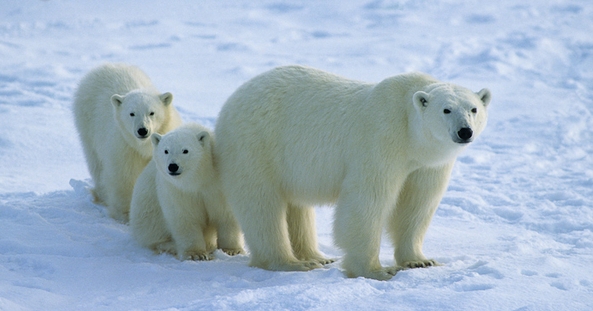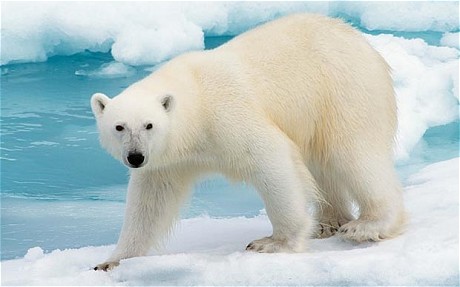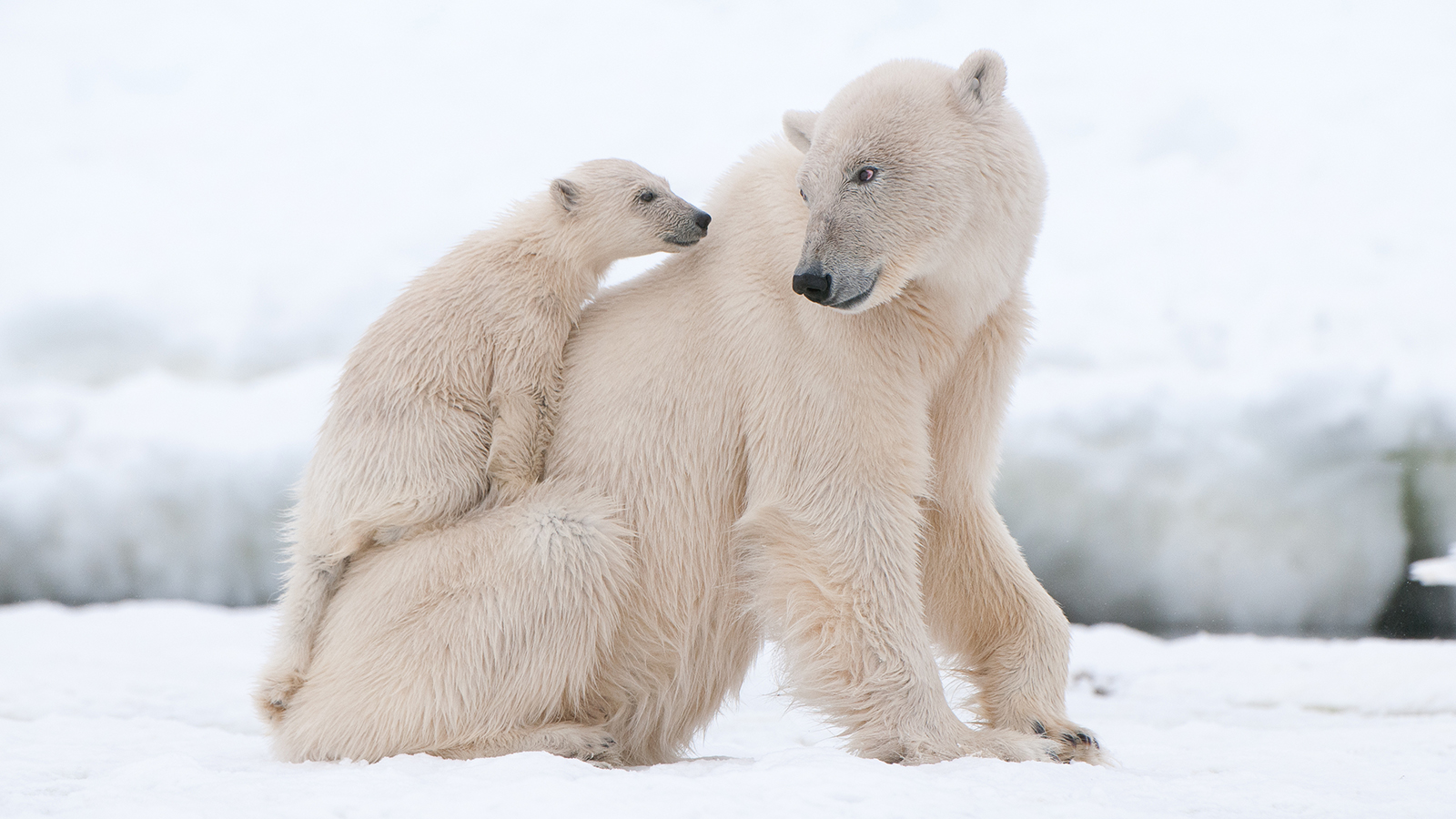
Protected from cold by a thick fur coat and a
layer of blubber, the polar bear hunts seals in
open areas in the Arctic sea ice.Astrong swimmer,
the polar bear uses its large front paws as paddles.
Its white fur blends in with the ice and
snow as it stalks or still-hunts seals. Ringed seals
are the polar bear's primary food, but it also
consumes bearded seals, and occasionally walruses,
belugas, narwhals, musk oxen, and carrion
(dead terrestrial and marine mammals). Although
largely carnivorous, when on land the polar bear
may eat grasses, kelp, berries, and lichens. Males
and nonpregnant females do not make dens or
hibernate, but spend the winter hunting on the
sea ice. The polar bear evolved from the terrestrial
brown bear about 100,000 to 200,000 years ago. In
captivity, polar bears and brown bears have interbred
and produced fertile offspring. This shows a
high degree of genetic relatedness. In nature,
however, these two species are geographically
isolated fromone another and would rarely meet.
Swimming in icy water among the ice floes of
the Arctic, quietly stalking a resting seal, then killing
it with a crushing blow of its forepaw, the polar
bear is an impressive example of an animal's
ability to adapt to and live in one of the harshest
environments on earth.
Physical Characteristics of Polar Bears
Male polar bears are up to five feet high at the
shoulder while on all fours and up
to ten feet long. When standing on
its hind legs, a male can be eleven
feet tall. Adult males are generally
much bigger than females: 1,100 to
1,770 pounds for males, 330 to 770
pounds for females. Like other
bears, polar bears are plantigrade.
Mating takes place in late March
to late May. This is the only time
that the male is with the female.
Other than family groups of females
with their cubs, polar bears
are solitary. Pregnant females dig
snow or earth dens in which they
will give birth to one to three cubs
in late November to early January.
The mother's milk is very rich, with
an average fat content of 33 percent.
The cubs, which weigh 1 to 1.5
pounds at birth, grow quickly and
weigh 22 to 33 pounds when they
emerge from the den with their
mother in late February to early
May. Polar bear cubs usually leave
their mother at 2.5 years of age,
at which time the mother is ready
to breed again. Therefore, the female
usually gives birth every third
year.
Conservation
By the 1960's, polar bear populations were in
serious decline due to sport hunting. In 1967, the
five "polar bear nations" (the United States, Canada,
Denmark, Norway, and the Soviet Union)
limited hunting to the Inuit (Eskimo) people.
By 2001, polar bears had recovered, and there
were twenty thousand to forty thousand in the
world.
A 1999 study by longtime polar bear biologist
Ian Stirling and his colleagues shows that polar
bears at Hudson Bay are 10 percent thinner and
have 10 percent fewer cubs than they did twenty
years ago. In 1999, the ice on Hudson Bay melted
three weeks earlier than it did twenty-five years
earlier. Polar bears must wait for ice to form each
fall to hunt ringed seals, their main food source.
Hudson Bay polar bears fast six to eight months
each year and then hunt seals intensively during
the ice season. The three-week reduction of hunting
time has not yet resulted in significant decline
of the polar bear population, but is expected to do
so if the climate trend continues.
Polar Bear Facts
Classification:
Kingdom: Animalia
Subkingdom: Bilateria
Phylum: Chordata
Subphylum: Vertebrata
Class: Mammalia
Subclass: Eutheria
Order: Carnivora
Suborder: Fissipedia
Family: Ursidae
Subfamily: Ursinae
Genus and species: Ursus maritimus
Geographical location: Northern marine areas of Alaska, Canada,
Greenland, Norway*s Svalbard Archipelago, and Russia
Habitat: The sea ice and adjacent land areas of the circumpolar
Arctic
Gestational period: About eight months
Life span: Up to thirty-two years in the wild, over forty years in
captivity
Special anatomy: Fur, hide, and blubber providing effective insulation
from the extreme arctic cold; white fur providing camouflage
against the backdrop of ice and snow and greatly
aiding in stalking seals; large paws used for paddling in water
and which act like snowshoes on thin ice; pads of the feet covered
with small, soft papillae that improve traction on ice;
small ears and tail to reduce heat loss and a large body mass to
conserve heat
Other popular Animals
Photo Gallery of - Polar Bear








 Animalia Life
Animalia Life